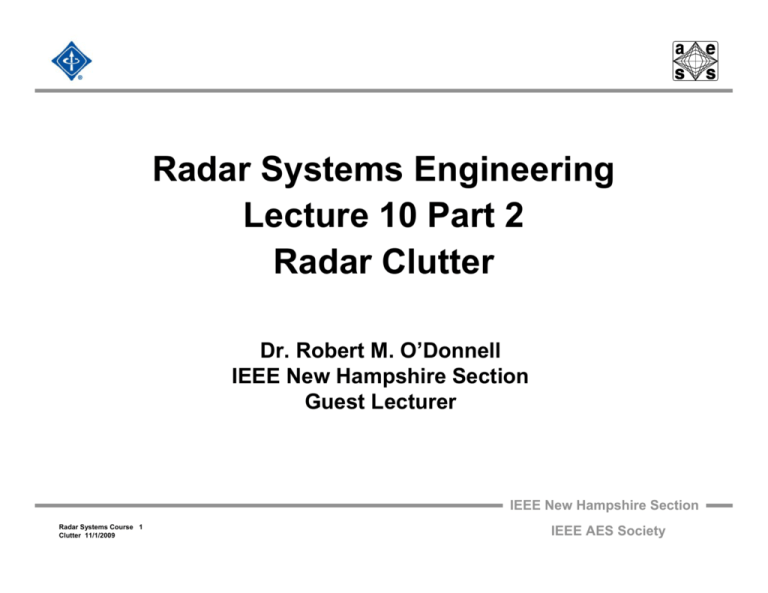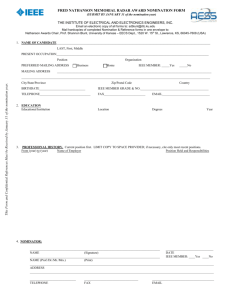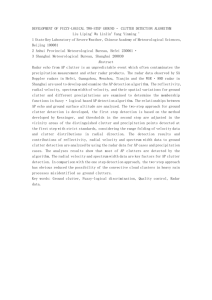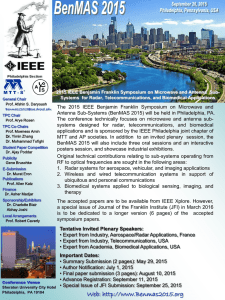Radar 2009 A_10 Radar Clutter.2pdf
advertisement

Radar Systems Engineering Lecture 10 Part 2 Radar Clutter Dr. Robert M. O’Donnell IEEE New Hampshire Section Guest Lecturer IEEE New Hampshire Section Radar Systems Course 1 Clutter 11/1/2009 IEEE AES Society Block Diagram of Radar System Transmitter Propagation Medium Target Radar Cross Section Power Amplifier Waveform Generation T/R Switch Antenna Buildings (Radar Clutter) Signal Processor Computer Receiver A/D Converter Pulse Compression Clutter Rejection (Doppler Filtering) User Displays and Radar Control General Purpose Computer Tracking Parameter Estimation Thresholding Detection Data Recording Photo Image Courtesy of US Air Force Used with permission. Radar Systems Course Clutter 11/1/2009 2 IEEE New Hampshire Section IEEE AES Society Outline • Motivation • Backscatter from unwanted objects – Ground – Sea – Rain – Birds and Insects Radar Systems Course Clutter 11/1/2009 3 IEEE New Hampshire Section IEEE AES Society Attributes of Rain Clutter • Rain both attenuates and reflects radar signals • Problems caused by rain lessen dramatically with longer wavelengths (lower frequencies) – Much less of a issue at L-Band than X-Band • Rain is diffuse clutter (wide geographic extent) – Travels horizontally with the wind – Has mean Doppler velocity and spread Reflected Electromagnetic Wave Rain drop Transmitted Electromagnetic Wave Radar Systems Course Clutter 11/1/2009 4 IEEE New Hampshire Section IEEE AES Society PPI Display Radar Normal Video Clear Day (No Rain) 10 nmi Range Rings on PPI Display August 1975, FAA Test Center Atlantic City, New Jersey Courtesy of FAA Airport Surveillance Radar S Band Detection Range - 60 nmi on a 1 m2 target Radar Systems Course Clutter 11/1/2009 5 IEEE New Hampshire Section IEEE AES Society PPI Display Radar Normal Video Clear Day (No Rain) Day of Heavy Rain 10 nmi Range Rings on PPI Display August 1975, FAA Test Center Atlantic City, New Jersey Courtesy of FAA Airport Surveillance Radar S Band Detection Range - 60 nmi on a 1 m2 target Radar Systems Course Clutter 11/1/2009 6 Courtesy of FAA 10 nmi Range Rings on PPI Display August 1975, FAA Test Center Atlantic City, New Jersey IEEE New Hampshire Section IEEE AES Society Reflectivity of Uniform Rain (σ in dBm2/m3) Figure by MIT OCW. • Rain reflectivity increases as f 4 (or 1 / λ4) – Rain clutter is an issue at S-Band and a significant one at higher frequencies Radar Systems Course Clutter 11/1/2009 7 IEEE New Hampshire Section IEEE AES Society Effect of Circular Polarization on Rain Backscatter • Assumption: Rain drops are spherical • Circular polarization is transmitted (assume RHC), – • Radar configured to receive only the sense of polarization that is transmitted (RHC) – • Reflected energy has opposite sense of circular polarization (LHC) Then, rain backscatter will be rejected (~ 15 dB) Most atmospheric targets are complex scatterers and return both senses of polarization; equally (RHC & LHC) – Target echo will be significantly attenuated Reflected Electromagnetic Wave Left Handed Circular (LHC) Rain drop Transmitted Electromagnetic Wave Right Handed Circular (RHC) Radar Systems Course Clutter 11/1/2009 8 Phase change at reflection point in raindrop IEEE New Hampshire Section IEEE AES Society Attenuation in Rain Attenuation from rain - dB/km (one way) 10 Attenuation at 18° C Rainfall Characterization 1 Drizzle – 0.25 mm/hr Light Rain – 1 mm/hr Moderate Rain – 4 mm/hr Heavy Rain – 16 mm/hr Excessive rain – 40 mm/hr 40 mm/hr 10-1 16 mm/hr 10-2 In Washington DC 4 mm/hr 0.25 mm/hr exceeded 450 hrs/yr 1 mm/hr exceeded 200 hrs/yr 4 mm/hr exceeded 60 hrs/yr 16 mm/hr exceeded 8 hrs/yr 40 mm/hr exceeded 2.2 hrs/yr 1 mm/hr 10-3 0.25 mm/hr 10-4 0 Radar Systems Course Clutter 11/1/2009 1 9 2 3 4 5 6 7 Wavelength (cm) 8 9 10 Adapted from Skolnik, Reference 6 IEEE New Hampshire Section IEEE AES Society Reflectivity vs. Frequency 10-4 Rain (15 mm/hr) Reflectivity (mi-1) 10-6 1 m2 on ASR radar (10kft at 30 nmi) 10-8 10-10 Insects (Maximum Observed) 10-12 Refractivity Fluctuations (Maximum Observed) 10-14 10-16 100 1,000 10,000 100,000 Frequency (MHz) Radar Systems Course Clutter 11/1/2009 10 IEEE New Hampshire Section IEEE AES Society Reflectivity of Uniform Rain (σ in dBm2/m3) Frequency S 3.0 GHz Rain Type Heavy Stratus Clouds Drizzle, 0.25 mm/hr Light Rain, 1 mm/hr Moderate, 4 mm/hr Heavy Rain, 16 mm/hr Reflectivity –102 –92 –83 –73 C 5.6 –91 –81.5 –72 –62 X 9.3 Ku 15.0 Ka 35 W 95 mm 140 –81 –72 –62 –53 –100 –71 –62 –53 –45 –85 –58 –49 –41 –33 –69 –45* –43* –38* –35* –62 –50* –39* –38* –37* π5 2 σ = 4 K ∑ D6 λ λ = Wavelength n2 − 1 K = 2 n +1 2 Complex Index of Refraction = 0.93 For Rain D = Droplet Diameter Radar Systems Course Clutter 11/1/2009 11 * Approximate Date Table Adapted from Nathanson, Reference 3 IEEE New Hampshire Section IEEE AES Society Heavy Uniform Rain – Backscatter Coefficient C Band Azimuth 17° Elevation 6° Pulse Width 1.6 μsec 3 dB Amplitude (Linear Units) 11,000 ft Altitude 40 mm*/hr 7 dB 10 mm*/hr 1.75 nmi 4.0 21.5 Slant Range, nmi Altitude 11.5 k-ft 12.1 k-ft 12.8 k-ft Range of Altitude 2.2 dB C Band Azimuth 336° Elevation 34° Pulse Width 0.2 μsec 9 dB 11,500 ft to 12,800 ft 0.2 nmi 2.6 Slant Range, nmi * Theoretical Rainfall Rate Radar Systems Course Clutter 11/1/2009 12 4.5 Adapted from Nathanson, Reference 3 IEEE New Hampshire Section IEEE AES Society Measured S-Band Doppler Spectra of Rain 0 – 10 – 20 – 30 – 40 – 50 – 60 – 70 – 80 – 90 – 60 Kt 0 + 60 Kt Doppler Velocity • • • • 0 – 10 – 20 – 30 – 40 – 50 – 60 – 70 – 80 – 90 Azimuth = 320° Azimuth = 330° 0 – 10 – 20 – 30 – 40 – 50 – 60 – 70 – 80 – 90 – 60 Kt 0 + 60 Kt – 60 Kt Rain is not Gaussian Mean velocity varies as storm moves by radar In these examples the rainfall rate was approximately 20 mm/hr Winds 30 kts on ground, 50 kts at 6000 ft 0 + 60 Kt Doppler Velocity Doppler Velocity dB dB Azimuth = 90° 0 – 10 – 20 – 30 – 40 – 50 – 60 – 70 – 80 – 90 Velocity Spread 6 kts – 60 Kt 0 + 60 Kt Doppler Velocity Radar Systems Course Clutter 11/1/2009 13 IEEE New Hampshire Section IEEE AES Society Effects of Wind Shear on the Doppler Spectrum Cross Sectional Sketch of Radar Beam With Wind Blown Rain Wind Velocity Δv R vR2 Relative Power Vertical Gradient of Wind (Wind Shear) v W (h ) Velocity Spectrum Of Rain v R1 vR2 vR0 0.5 v R1 Doppler Velocity Adapted from Nathanson, Reference 3 Radar Systems Course Clutter 11/1/2009 14 IEEE New Hampshire Section IEEE AES Society Nathanson Rain Spectrum Model • Nathanson model for velocity spread of rain σv = σ 2 Shear +σ 2 Turb +σ 2 Beam ( +σ 2 Fall σ Shear = 0.42 k R φ (m / s ) σ Shear ≤ 6.0 σ Turb = 1.0 (m / s ) ) σ Beam = 0.42 w o θ sin β (m / s ) σ Fall = 1.0 sin ψ (m / s ) • k = Wind Shear Gradient (m/s/km) (~4.0 averaged over 360°) R = Slant range (km) and vertical two θ ,φ = Horizontal way beam widths (radians) rel. to beam direction β = Azimuth at beam center ψ = Elevation angle wo = Wind speed (m/s) Typical Values: σ Shear ≈ 3.0 m / s σ Beam ≈ 0.25 m / s σ Turb ≈ 1.0 m / s σ Fall ≈ 1.0 m / s σ v ≈ 3.3 m / s Adapted from Nathanson, Reference 3 Radar Systems Course Clutter 11/1/2009 15 IEEE New Hampshire Section IEEE AES Society Outline • Motivation • Backscatter from unwanted objects – Ground – Sea – Rain – Birds and Insects Radar Systems Course Clutter 11/1/2009 16 IEEE New Hampshire Section IEEE AES Society Bird Clutter • General properties • Bird populations and density – Migration / Localized travel Land / Ocean – Variations Geography, Height, Diurnal, Seasonal etc • Radar Cross Section – Mean / Fluctuation properties • Velocity / Doppler Distribution • Effects of Birds on radar – Sensitivity Time Control (STC) Radar Systems Course Clutter 11/1/2009 17 IEEE New Hampshire Section IEEE AES Society General Properties of Birds • Good RCS model for bird – Flask full of salt water – Expanding and contracting body, at frequency of wing beat, is the dominant contributor to individual bird radar cross section fluctuations • Since many birds are often in the same range-azimuth cell, the net total backscatter is the sum of contribution from each of the birds, each one moving in and out of phase with respect to each other. Erlenmeyer Flask Snow Goose Courtesy of tk-link Courtesy of pbonenfant Radar Systems Course Clutter 11/1/2009 18 Sea Gull Courtesy of jurvetson IEEE New Hampshire Section IEEE AES Society General Properties of Birds • Since birds move at relatively low velocities, their speed, if measured, can be used to preferentially threshold out the low velocity birds. – Direct measurement of Doppler velocity – Velocity from successive measurement of spatial position Range and angle • Even though the radar echo of birds is relatively small, birds can overload a radar with false targets because: – Often bird densities are quite large, and – Bird cross sections often fluctuate to large values. • A huge amount of relevant research has been done over the last 20 years to quantify: – The populations of bird species, their migration routes, and bird densities, etc., using US Weather radar data (NEXRAD) – Major Laboratory efforts over at least the last 20 years at Clemson University and Cornell University Radar Systems Course Clutter 11/1/2009 19 IEEE New Hampshire Section IEEE AES Society Bird Clutter • General properties • Bird populations and density – Migration / Localized travel Land / Ocean – Variations Geography, Height, Diurnal, Seasonal etc • Radar Cross Section – Mean / Fluctuation properties • Velocity / Doppler Distribution • Effects of Birds on radar – Sensitivity Time Control (STC) Radar Systems Course Clutter 11/1/2009 20 IEEE New Hampshire Section IEEE AES Society Bird Breeding Areas and Migration Routes Gadwall Northern Flicker Virginia Rail Photos courtesy of vsmithuk, sbmontana, and khosla. Figure by MIT OCW. Along the Gulf Coast, during the breeding season, wading and sea bird colonies exist that have many tens of thousands of birds. Ten thousand birds are quite common. These birds are large; weighing up to 2 lbs and having wingspreads from 1 to 6 feet. Radar Systems Course Clutter 11/1/2009 21 IEEE New Hampshire Section IEEE AES Society Bird Breeding Areas and Migration Routes Spotted Towhee Black Tern Northern Harrier Photos courtesy amkhosla, Changhua Coast Conservation Action, and amkhosla. Figure by MIT OCW. In the lower Mississippi Valley, over 60 blackbird roosts have been identified with greater than 1 million birds each. Many smaller roosts also exits. These birds disperse several tens of miles for feeding each day. Radar Systems Course Clutter 11/1/2009 22 IEEE New Hampshire Section IEEE AES Society Density of Migrating North American Birds Data Characteristics 286 Sites 1209 Observations ~3000 Count-hours Count = #/mi2/hr 5 4 3 2 13% at 0 Density Frequency of Occurrence (% / dB) Evening of 3 - 4 October 1952 1 50% 75% 1 10 25% 10% 100 1% 1000 Number of birds per sq mi Adapted from Pollon, reference 7 Radar Systems Course Clutter 11/1/2009 23 IEEE New Hampshire Section IEEE AES Society Migratory Bird Patterns (Off the US New England Coast) Direction of Bird Migration Circles note coverage of 2 radars, one at tip of Cape Cod, the other, offshore on a “Texas tower” Bird migrations have been tracked by radars from the Northeast United States to South America and the Caribbean have on Bermuda at altitudes of 17 kft Adapted from Eastwood reference 8 Radar Systems Course Clutter 11/1/2009 24 IEEE New Hampshire Section IEEE AES Society Bird Migration across the Mediterranean Sea 10°W 0° 10°E 20°E 30°E 45° 35° Spring 600 nmi. Autumn Adapted from Eastwood reference 8 Radar Systems Course Clutter 11/1/2009 25 For about 2 1/2 months in the Spring and Autumn, there is heavy bird migration, to and from, Europe and Africa IEEE New Hampshire Section IEEE AES Society Altitude Distribution of Migrating Birds 7 6 Height (ft x 1000) Altitude distributions differ for migrating and non-migrating birds Nocturnal Migrating Birds Bushy Hill, England Spring 1966 5 The presence of cloud cover effects the bird height distribution 4 Distance of their migration can influence migration altitude (NE United States to South America) 3 Over land vs. over sea migration 2 Day vs. night migration 1 0 Non-migrating birds stay closer to the ground 0 2 4 6 8 10 Percent of Birds Detected 12 Adapted from Eastwood, reference 8 Radar Systems Course Clutter 11/1/2009 26 IEEE New Hampshire Section IEEE AES Society Example of “Ring Roost” Phenomena Note intensity scale in dBZ “Ring Roosts” are flocks of birds leaving their roosting location for their daily foraging for food just before sunrise Data collected on August 10, 2006 5:25 to 6:15 AM About 50 minutes of data is compressed into ~1.5 sec duration and replayed in a loop Courtesy of NOAA • Radar observations with C-Band, WSR-88 (NEXRAD) NOAA, Pencil Beam Radar located at Green Bay, Wisconsin Radar Systems Course Clutter 11/1/2009 27 IEEE New Hampshire Section IEEE AES Society Spring Bird Migration from Cuba to US Note intensity scale in dBZ Data collected on April 28, 2002 ~1 - 3 AM About 2 hours of data is compressed into ~3 sec duration and replayed in a loop • Radar observations with C-Band, WSR-88 (NEXRAD) NOAA, Pencil Beam Radar located at Key West, Florida Radar Systems Course Clutter 11/1/2009 28 IEEE New Hampshire Section IEEE AES Society Bird Clutter • General properties • Bird populations and density – Migration / Localized travel Land / Ocean – Variations Geography, Height, Diurnal, Seasonal etc • Radar Cross Section – Mean / Fluctuation properties • Velocity / Doppler Distribution • Effects of Birds on radar – Sensitivity Time Control (STC) Radar Systems Course Clutter 11/1/2009 29 IEEE New Hampshire Section IEEE AES Society Bird RCS Measurements Joint Air Force NASA Radar Facility Wallops Island, VA Radar Cross Section vs. Time -2 10 Radar Cross Section (m2) Sparrow S-Band UHF , S-Band and X-Band Radars 10-3 10-4 0 2 1 3 Time (min) • In the late 1960s, Konrad, Hicks, and Dobson of JHU/APL accurately measured the radar cross section (RCS) of single birds and the RCS fluctuation properties. – Bird RCS fit a log-normal quite well – Like the Weibull distribution, it is a 2 parameter model that fits data with long tails Adapted from Konrad, reference 12 Radar Systems Course Clutter 11/1/2009 30 IEEE New Hampshire Section IEEE AES Society Summary of Measured Bird Cross Section* Data X-Band S-Band Grackle (male) 15.7 27 0.73 Grackle (female) 15.4 23.2 0.41 Sparrow 1.85 14.9 0.025 Pigeon 14.5 80.0 Units of RCS measurement UHF 10.5 cm2 Adapted from Konrad, reference 12 Radar Systems Course Clutter 11/1/2009 31 IEEE New Hampshire Section IEEE AES Society Distribution of Bird Radar Cross Section Number of Bird Detections 80 60 40 20 0 10-5 10-4 10-3 10-2 10-1 1 Radar Cross Section (m2) Radar Systems Course Clutter 11/1/2009 32 10 Adapted from Eastwood, reference 8 IEEE New Hampshire Section IEEE AES Society Radar Cross Section Model Wavelength Mean Cross Section (dBsm) Standard Deviation of Log of Cross Section (dB) X –33 6 S –27 6 L –28 7.5 UHF –47 15 VHF –57 17 • • Wavelength dependence Fluctuation statistics of cross section (log normal) Adapted from Pollon, Reference 7 Radar Systems Course Clutter 11/1/2009 33 IEEE New Hampshire Section IEEE AES Society Bird Clutter • General properties • Bird populations and density – Migration / Localized travel Land / Ocean – Variations Geography, Height, Diurnal, Seasonal etc • Radar Cross Section – Mean / Fluctuation properties • Velocity / Doppler Distribution • Effects of Birds on radar – Sensitivity Time Control (STC) Radar Systems Course Clutter 11/1/2009 34 IEEE New Hampshire Section IEEE AES Society Distributions of the Radial Velocity of Birds L-Band 0.20 0.15 0.10 0.05 0 0 5.7 11.4 17.1 22.8 28.5 Radial Velocity (m/sec) Radar Systems Course Clutter 11/1/2009 35 Frequency of Occurrence Frequency of Occurrence X-Band 0.30 0.25 0.20 0.15 0.10 0.05 0 0 5.7 11.4 17.1 22.8 28.5 Radial Velocity (m/sec) IEEE New Hampshire Section IEEE AES Society Bird Clutter • General properties • Bird populations and density – Migration / Localized travel Land / Ocean – Variations Geography, Height, Diurnal, Seasonal etc • Radar cross section – Mean / Fluctuation properties • Velocity / Doppler distribution • Effects of birds on radar – Sensitivity Time Control (STC) Radar Systems Course Clutter 11/1/2009 36 IEEE New Hampshire Section IEEE AES Society Detectable Cross Section (m2) Why Birds Are an Issue for Radars 101 70 km t a 10 m 0 km 2 at 7 -2 m 10 km 2 at 70 -3 m 10 -1 1 Detection Curve For an ASR 10-1 2 10-2 Birds 10-3 Insects Clear Air Turbulance 10-4 0 20 40 60 80 100 120 140 160 Range (km) Radar Systems Course Clutter 11/1/2009 37 IEEE New Hampshire Section IEEE AES Society Sensitivity Time Control Aircraft at 200 nmi, RCS = 1 m2 Bird at 89 nmi, RCS = 0.0015 m2 • • These two targets have the same detectability, because in the radar equation: S σ N ∝ R4 This false target issue can be mitigated by attenuating to the received signal by a factor which varies as 1/R4 – Can also be accomplished by injecting 1/R4 noise to the receive channel • Radars that utilize range ambiguous waveforms, cannot use STC, because long range targets which alias down in range, would be adversely attenuated by the STC – For these waveforms, other techniques are used to mitigate the false target problem due to birds Radar Systems Course Clutter 11/1/2009 38 IEEE New Hampshire Section IEEE AES Society Bird Example from Dallas-Fort Worth Radar & Beacon Beacon-Only Radar Uncorrelated Radar Correlated Radar Systems Course Clutter 11/1/2009 39 IEEE New Hampshire Section IEEE AES Society Bird Clutter Issues - Summary • Birds are actually moving point targets – • Velocity usually less than 60 knots Mean radar cross section is small, but a fraction of bird returns fluctuate up to a high level (aircraft like) – Cross section is resonant at S-Band and L-Band • The density of birds varies a lot and can be quite large – 10 to 1000 birds / square mile • Birds cause a false target problem in many radars – This can be a significant issue for when attempting to detect targets with very low cross sections Radar Systems Course Clutter 11/1/2009 40 IEEE New Hampshire Section IEEE AES Society Insects • • • • • Figure by MIT OCW. Radar Systems Course Clutter 11/1/2009 41 Insects can cause false detections and prevent detection of desired targets Density of insects can be many orders of magnitude greater than that of birds Insect flight path generally follows that of the wind Cross section can be represented as a spherical drop of water of the same mass Insect echoes broad side are 10 to 1,000 times than when viewed end on Adapted from Skolnik Reference 6 IEEE New Hampshire Section IEEE AES Society Mayfly Hatching Mississippi River Data collection - June 30, 2006 La Crosse is the breeding ground of the mayfly population of the world ~10s of billions of them hatch, live, and die, over a 1 ½ day period, each year in late June / early July Ephemeroptera (mayfly) Courtesy of urtica Courtesy of National Weather Service • Radar observations with C-Band, WSR-88 (NEXRAD) NOAA, Pencil Beam Radar located at La Crosse, Wisconsin (SW WI) Radar Systems Course Clutter 11/1/2009 42 IEEE New Hampshire Section IEEE AES Society Summary • A number of different types of radar clutter returns have been described – Ground, sea, rain, and birds • These environmental and manmade phenomena will produce a variety of discrete and diffuse, moving and stationary false targets, unless they are dealt with effectively • A number of signal and data processing techniques can be used to suppress the effect of these radar clutter returns. Radar Systems Course Clutter 11/1/2009 43 IEEE New Hampshire Section IEEE AES Society References 1. Billingsley, J. B. , Ground Clutter Measurements for Surface Sited Radar, MIT Lincoln Laboratory, TR-916 Rev 1, (1991) 2. Billingsley, J. B., Low Angle Radar Land Clutter, Artech House, Needham, MA, (2005) 3. Nathanson,F. , Radar Design Principles, McGraw Hill, New York,2nd Ed., (1999) 4. Skolnik, M., Radar Handbook, McGraw Hill, New York,3rd Ed., (2008) 5. Barton, D., Radar System Analysis, McGraw Hill, Artech House, Needham, MA, (1976) 6. Skolnik, M., Introduction to Radar Systems, McGraw Hill, New York, 3rd Ed. (2000) Radar Systems Course Clutter 11/1/2009 44 IEEE New Hampshire Section IEEE AES Society References - Continued 7. Pollon, G., “Distributions of Radar Angels,” IEEE Trans. AESS, Volume AES-8, No. 6, November 1972, pp. 721–726 8. Eastwood, E., Radar Ornithology, Methuen & Co, London, (1967) 9. Riley,J. R., “Radar Cross Section of Insects,” Proceedings of IEEE, February 1985, pp. 228–232 10. Vaughn, C. R., “Birds and Insects as Radar Targets: A Review,” Proceedings of IEEE, February 1985, pp. 205–227 11. Billingsley, J. B. , Ground Clutter Measurements for Surface Sited Radar, MIT Lincoln Laboratory, TR-786 Rev 1, (1993) 12. Konrad, et al, “Radar Characteristics of birds in Flight”, Science, vol 159, January 19, 1968 Radar Systems Course Clutter 11/1/2009 45 IEEE New Hampshire Section IEEE AES Society Homework Problems • From Skolnik, Reference 6 – Problems 7-2, 7.4, 7.9, 7.11, 7.15, and 7.18 Radar Systems Course Clutter 11/1/2009 46 IEEE New Hampshire Section IEEE AES Society








